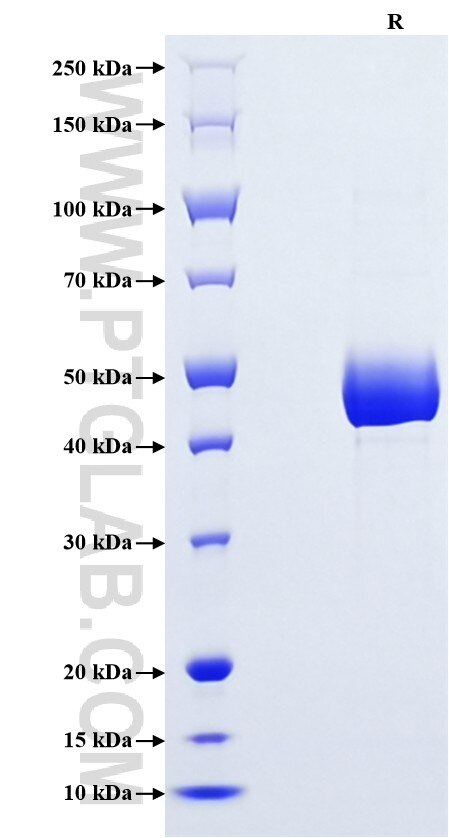Recombinant Human BAFF/TNFSF13B protein (rFc Tag)
Species
Human
Purity
>90 %, SDS-PAGE
Tag
rFc Tag
Activity
not tested
Cat no : Eg1970
Validation Data Gallery
Product Information
| Purity | >90 %, SDS-PAGE |
| Endotoxin | <0.1 EU/μg protein, LAL method |
| Activity |
Not tested |
| Expression | HEK293-derived Human BAFF protein Ala134-Leu285 (Accession# Q9Y275-1) with a rabbit IgG Fc tag at the N-terminus. |
| GeneID | 10673 |
| Accession | Q9Y275-1 |
| PredictedSize | 44.2 kDa |
| SDS-PAGE | 43-55 kDa, reducing (R) conditions |
| Formulation | Lyophilized from 0.22 μm filtered solution in PBS, pH 7.4. Normally 5% trehalose and 5% mannitol are added as protectants before lyophilization. |
| Reconstitution | Briefly centrifuge the tube before opening. Reconstitute at 0.1-0.5 mg/mL in sterile water. |
| Storage Conditions |
It is recommended that the protein be aliquoted for optimal storage. Avoid repeated freeze-thaw cycles.
|
| Shipping | The product is shipped at ambient temperature. Upon receipt, store it immediately at the recommended temperature. |
Background
TNFSF13B, also known as BAFF, BLYS, TALL1, TNFSF20, ZTNF4 and CD257, is a cytokine that binds to TNFRSF13B/TACI and TNFRSF17/BCMA. This cytokine is expressed in B lineage cells, and acts as a potent B cell activator. The BAFF system promotes B cell survival and differentiation and plays a prominent role in the pathogenesis of autoimmune diseases. It has been shown that BAFF inhibitors are in clinical trials for systemic lupus erythematosus with significant efficacy.
References:
1. Cristian R Smulski et al (2018). Front Immunol. Oct 8;9:2285. 2. Edina Schweighoffer et al (2021). Curr Opin Immunol. Aug;71:124-131. 3. Anne Davidson. (2010). Curr Opin Immunol. Dec;22(6):732-9. 4. Shingo Nakayamada et al (2016).Inflamm Regen. Jul 21;36:6.
